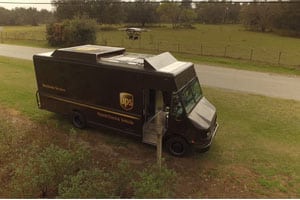Amazon, Walmart and Google now have company in the U.S. skies, and the drone wars have been stepped up a notch.
UPS this week successfully tested a drone deployed from the top of a delivery van in a rural area outside Tampa, FL, delivering a package to a home then returning to the vehicle. The drone was from electric truck and drone developer Workhorse Group.
UPS has also been involved in regular drone delivery of medicines to clinics and hospitals in remote areas of Rwanda in partnership with drone maker Zipline; in tests of indoor drones to retrieve items high up in warehouses in the Netherlands at its own facility in Louisville, KY; and last fall sent medicine by a CyPhy Works drone to an island three miles off the coast of Massachusetts in a non-emergency test.
[Related: Amazon Prime Air to test Drone Delivery in the UK]
In the Florida test, the drone was docked on the roof of the delivery truck. The driver loaded a package into a cage suspended beneath the drone that extended through a hatch into the truck. He then pressed a button on a touchscreen, sending the drone on a preset autonomous route. The battery-powered HorseFly drone recharges while it’s docked, has a 30-minute flight time and can carry a package weighing up to 10 pounds.

The test in Florida was a use case for drones to help gain efficiency in delivery operations, said Jerome Ferguson, director of autonomous systems for UPS. Rural delivery routes are the most expensive to serve for UPS, due to the time and vehicle expenses required to complete each delivery. That plus their remote nature is why the company is envisioning it as the logical place for drone use.
[Related: Amazon Wins Patent for Flying FC, Blows Out Holidays]
“In rural or super-rural areas, you can imagine a triangle where the driver loads the item into the drone, the drone goes in one direction, the driver continues on the route, and after the drone completes the delivery it makes a rendezvous with the driver at another location,” Ferguson said. “It could help us be more efficient at times like peak season, when we have tens of thousands of helpers aiding drivers in delivery operations.”
During the test there were two spotters monitoring the operation for safety, and a pilot to take over the drone if there was wind or mechanical issues.
[Related: Walmart Enters Drone Airspace with Amazon, Google]
“In the future we expect the technology to evolve further, include ‘sense and avoid’ capability,” Ferguson said. “The Federal Aviation Administration’s primary focus is to keep the airways safe. ‘Sense and avoid’ is certainly high on the list for the FAA, and goes hand in glove with the line-of-sight (piloting) requirement.”
Ferguson added that he sees regular commercial use of drone delivery a still being a few years out, and UPS is working closely with the FAA to help make policy recommendations. In fact he was meeting with an FAA drone advisory subcommittee this week.
Efficiency is especially critical as UPS is looking for ways to rein in rising costs from the massive growth in expensive ecommerce deliveries, and said it may consider across-the-board price increases to offset pressure on margins, according to the company’s CFO in a report in Reuters. Its access point location program – using 3,000 UPS stores and small businesses like convenience stores as collection points – is another way the company is looking to save costs by increasing ecommerce package density.
Mike O’Brien is Senior Content Manager of Multichannel Merchant
